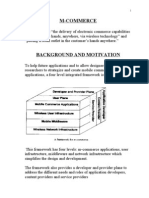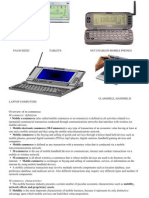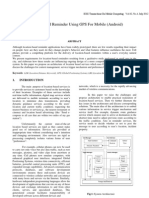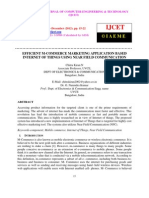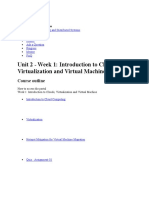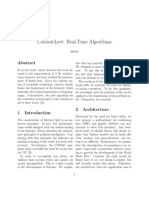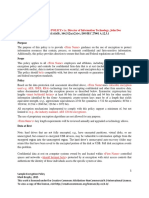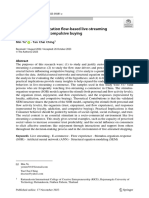M-COMMERCE SERVICES: PROMISES AND CHALLENGES
John Mathew Washington State University Suprateek Sarker Copenhagen Business School/ Washington State University Upkar Varshney Georgia State University uvarshne@cis.gsu.edu ABSTRACT This paper provides a brief description of two distinct approaches for designing and implementing M-Commerce services, the dominant location-based approach, and the gradually emerging context-based approach. The authors argue that the context-based approach, while more complex, holds greater potential for the future, given its inherent capability to reflect/support natural human social structures and behaviors. KEYWORDS: M-commerce services, mobile technology, context-based services, location-based services. I. INTRODUCTION M-commerce refers to the emerging arena within which commercial transactions are made possible using handheld mobile devices that are connected by wireless networks. A predominant characteristic of M-commerce is that a person engaged in M-commerce can conduct business literally anywhere, even when wandering around, traveling between places, or visiting a different location [Kristoffersen and Ljungberg 2000]. While E-commerce using tethered devices1 (such as personal computers) brought about a business transformation enabling people to conduct transactions at anytime (with limited freedom from place), M-commerce seeks to provide a new level of service availability, by removing almost all place-related constraints associated with conducting commerce. The interest in M-commerce is substantial, both among individual consumers and businesses. From the service providers standpoint, mobile voice communication is estimated to increase at a relatively lower growth rate in the next few years. Thus, the real potential, notwithstanding current
We henceforth refer to E-commerce using tethered devices as traditional E-commerce.
�difficulties2, is seen to be in enabling commerce (i.e., actual transactions or activities leading up to transactions) on mobile devices [Dekleva 2004]. Further, businesses familiar with traditional ecommerce realize that adding the mobile dimension to their e-commerce strategy is not likely to require drastic changes in their existing information systems. The expected low cost of entry into M-Commerce makes it attractive to organizations seeking to provide their goods/services over handheld devices. It must be emphasized that M-commerce not only includes traditional E-commerce applications running over mobile devices and wireless networks, but also includes many new applications that became possible due to unique capabilities of wireless environment and user mobility [Varshney and Vetter, 2002]. The increasing functionalities in devices, including the capability to handle voice, data, and video, the support for location tracking by some wireless networks and carriers in an increasing number of places, and the unprecedented growth in the number of mobile devices led to implementation of a unique class of services, called location-based services [Rao and Minakakis 2003]. II. LOCATION-BASED SERVICES THE FIRST STEP Locationbased services (LBS) are services that generate commercial activity by using geographic location (i.e., place-related) information of the mobile devices, along with information about services and products available in (certain degree of) physical proximity. LBS require devices, products, services, and places to be identified and located in the geographic space. These services generated great interest among researchers and developers, primarily due to the presumed potential for: user empowerment, the estimated market for location-based advertising, and the ability to handle many emergency situations.
A number of location-based mobile commerce services are illustrated in Figure 1 and briefly discussed in Table 1. Finding the geographic location of a device is commercially valuable because, in a mobile society, people and goods are in motion, and tend to become lost in this mobile environment [Cousins and Varshney, 2001]. If a service could help pinpoint the location of a mobile device to the degree of precision appropriate for different applications3 significant value could be added. Note that merely locating the device does not constitute a complete service. A device-locating service would have to be supported by other services such as providing directions or providing information (e.g., available services, products, and people) about the vicinity. In M-commerce based on location, users tend to be interested in finding the nearest services/stores or places of interest, compared to browsing the Internet from a wired connection. Wired users want information, often without location-related considerations, and then drill down to a specific location. For mobile users the opposite is true. Their starting point for informationseeking behaviors is often the location. Though this change in information requirement is subtle, the technological infrastructure required to provide information is quite different. Once the geographic location is identified, the information specific to that location must be delivered. Whether it is providing directions or providing information about the vicinity, the information (or
2
Examples of existing technological challenges include those associated with low battery life of devices, small simplistic displays, limited computing power, limited bandwidth, and even unreliable connections [e.g., Agarwal et al. 2003]. 3 For example, mobile inventory management would generally need precision levels within a few meters, mobile advertising within a few hundreds of meters, and proactive service management within a few kilometers.
�Patient Monitoring and Tracking
Locate a-Friend
Advertising Database User Preferences
-based Location Services
Specific Users
Specific Locations
Vendors & dealers
Locate Info
Mobile Advertising
Mobile Inventory/Product Location Tracking
Figure 1. Some Mobile Location-based Services
Table 1. Some Location-Based Services and their Characteristics Examples of Locationbased Services
Locate-Info
Description
Information on nearby places, maps, restaurants, hotels Specials offered by nearby businesses in conjunction with user interests. Searching for a certain item within an area Attempting to find the exact location of a certain friend, or any friend in a certain location Managing and acquiring inventory from tracking fixed and mobile suppliers Monitoring vital signs of patients in homes, hospitals, and nursing homes
Comments
1. More likely to be pull-oriented (provided to user on-demand) 2. Time-sensitive 1. More likely to be pushed to user based on users prior permission 2. Time-sensitive 1. Pull-oriented 2. Some delays can usually be tolerated; urgency is not high. 1. Pull-oriented 2. Some delays can usually be tolerated, though in many cases, urgency could be high! 1. Pull-oriented 2. Some delays can be tolerated; urgency is not required 1. Periodic tracking and monitoring required 2. Urgent actions may be required if vital signs cross a certain threshold
Mobile advertising
Product location tracking
Locate-a-friend
Mobile inventory management Patient Monitoring
�content) needs to be generated systematically or be tailored for the particular location of the device. Numerous techniques and technologies are involved in the process of content delivery to mobile devices (e.g., [Fano and Gershman, 2002]). All location-based services start with locating the device first and then providing additional information. An example of providing directions would be a user who requests alternate driving routes to a particular location. The current location of the device would be obtained, and a map service would plot alternate routes to the destination. Other examples of applications meaningful in the vicinity of the mobile device include: providing descriptions of and directions to certain kinds of restaurants (as requested by the user) within a half-a-mile radius; providing a historically-curious tourist in a city with relevant history associated with a monument on her mobile device as she passes by the monument. A potentially serious consideration for LBS is the latency of the current networks. Because information provided by LBS needs to be timely, network delays can sabotage the effectiveness of these services. For example, directions from Point A to Point B provided by a mobile service provider to an automobile driver is hardly meaningful, if due to latency, the user receives the driving directions when the vehicle is at Point C, where C is significantly removed from A. Different mobile and wireless networks are capable of providing different levels of location accuracy. Most widely used wireless networks, the wide-area public switched wireless networks (e.g. cellular, PCS, and GSM), are under FCC mandate to provide the location of mobile device within a 100 meter radius 2 out of 3 times. In the US as of 2004, although many of the wireless carriers do offer location tracking in some cities, a nationwide universal carrier-independent location capability does not exist. The use of multiple and diverse technologies by carriers, base station triangulation, time differential of arrival instances, and use of GPS signals, result in technical challenges that need to be addressed. Other technologies such as wireless LANs and RFID (radio frequency identification) can be used for location tracking independently or in combination with public wireless networks. These technologies offer accuracy of a few meters, but require a large number of base stations (wireless LANs) or RFID readers to provide coverage. These solutions can work better for slowly moving objects and can be used indoors and outdoors. A grid of wireless LANs or RFID readers can also provide vertical location4 accuracy, which is difficult to do for wide-area public switched wireless networks. III. CONTEXT-BASED SERVICES GOING BEYOND LOCATION INTRODUCTION Although location-based services are of interest and continue to be refined and developed, such services suffer from a fundamental limitation in that they rely on only one parameter of mobility (i.e., location) to generate revenue. Thus growth prospects are inherently limited. Moreover, LBS applications assume that use is determined by location, devoid of the surrounding context, which detracts from creating a socio-technical fit with the use process [Grudin 2002]. We believe that the mobile services that go beyond determining location (and are sensitive regarding the context of use) will rapidly expand in the near future to applications such as are shown in Figure 2 and Table 2.
Vertical location refers to the height above (or below) a reference point (e.g., height of a device above sea-level).
�Figure 2: Some Mobile Context-based Services
�Table 2: Current and Envisioned Context-Based Services Context-based services Multiple address books Description One address book for each context (Work address book, personal address book, etc.) Each caller is identified with a different ring tone. Comments Helps keep contacts separated by the context they are associated with the user. Not yet available. Since each user belongs to a particular context for the device user, a different ring tone signals a different context. Multiple ring tones are currently available. E.g. Friends from high school, or from work.
Multiple ring tones
Keep in touch with a group of friends
Since contexts may be based on groups of people, a user can send and track messages based on this group. For security purposes the device may contain many identifications of the person.
Multiple self identifications
Depending on the level of trust assigned to a context, the identification may be changed or only certain aspects of the ID may be revealed. Similar to an event journal. Will help the user remember events. E.g. If you are at home the device will not allow calls from telemarketers. If your child initiates a message from school it would be classified as family unless a teacher authenticates the message as a school context message.
Time, context and device mapping
The device keeps track of all the devices that were associated with it in a particular context at a point in time. Device understands the current context and changes certain settings to predefined ones. The presence or authorization from another device will prove that the context is true or valid.
Time and context awareness Context-based authentication
SCENARIO Consider the following scenario possible in the near future: A mobile device belonging to Tim (an executive) can detect the presence of other mobile devices. The device recognizes the other devices as those belonging to Tims colleagues based on some stored or acquired information such as the phone numbers in the address book, and recognizes the context as work. The device therefore shares only workrelated messages and calendar. When Tim visits his favorite resort for a family outing, the device detects a different set of mobile devices -- mobile devices belonging to his wife and his two daughters. Since these new devices are listed in the address book as family, the device recognizes them, determines that the context is family, and readily shares family matters such as the
�personal activities calendar. What is more interesting when Tim visits the same resort with his colleagues for their annual retreat, a context-sensitive service enabled device would be able to recognize that he was with work colleagues and make a different set of appropriate information available. Clearly, depending on the capabilities of the device and applications, many additional elements of context (including the location) could be captured and help inform the default behaviors of a mobile device. The point made in the scenario is that mobile applications based on location alone are useful, but limited in many instances, since location does not capture the situation within which an individual chooses to use the services. That is, location is but one dimension of context. It represents a static view of context as opposed to dynamism of situations that is inherent in mobile device use. THE CONCEPT The concept of context-based services hinges on the idea that devices may be in similar context but dissimilar locations or vice versa. Moreover, the context of a mobile device may also shift over time, even if location remains unchanged. Context-based services have generally been discussed as synonymous to location-based services (e.g., [Sacher et al. 2002]), perhaps, because of the manageable complexity of dealing with changing location (rather than changing context), and the focus on situations that potentially involve a technology-based universal solution. While the context can be conceptualized (and implemented) in numerous ways, one way to proceed is to define context of a mobile device based on the presence/proximity of other mobile5 devices. The scenario does require the device to: be able to sense the presence of other devices in a given space, communicate with the other devices, obtain their ID, and then automatically assign the context it is in, and display appropriate (pre-defined) characteristics and behaviors. (Going back to the scenario, surely, Tim does not want his grocery list distributed to his colleagues when they are visiting his home!)
As the device switches from one context to another, different context-based services are called upon. Each individual is associated with potentially infinite set of contexts, though many of them can be typified because they tend to be salient and are encountered repeatedly. Devices can be programmed to recognize such contexts (and their variations). Further, actions associated with a context can be prioritized. For example, a professor teaching a graduate class (recognized possibly by his/her mobile device based on the presence of a set of students mobile devices and/or a particular time in the calendar) would generally not appreciate being interrupted for a (non-time sensitive) chit-chat or informal conversation by a personal acquaintance or friend. However, the same professor teaching the same class may very well welcome a (time-sensitive) urgent interruption, due to, say, an emergency call from the hospital regarding someone who has been admitted to the hospital with serious illness. The key advantage of context-based services is that they parallel social situations and structures. As humans, we encounter different contexts every day, and over time, develop routines for actions within them. For example, Tim has the professional context, where he has colleagues that work with him. Certain actions are natural and legitimate in the work setting for an executive such as Tim. And then, Tim also has a family context, where he is associated with certain other responsibilities and behaviors. Naturally, Tim encounters other contexts such as when he meets with his high school friends, his golfing buddies, or teachers in his daughters school. As he If stationary telephone devices are also sensed, the context could incorporate physical location as well.
5
�switches from one context to another, his behaviors and characteristics are likely to change. Tims mobile device should be able to augment his capabilities in the different contexts. The device should be able to identify the social structure in which Tim is acting, and provide services accordingly. When a real context does not fit an existing pre-programmed context, just as Tim has to improvise, the mobile device of the future should be capable of intelligently inferring default behavior patterns appropriate to that setting. Ideally, devices need to combine prediction, using information/preferences from the user profile, sensing other mobile devices nearby, and learning from past actions to determine the current context. If the amount of processing or stored information exceeds the capability of a device, then asymmetric processing can be used, where one or more additional devices/servers can help the device determine the current context. Table 3 provides a comparison between location-based and context-based M-services.
Table 3: Comparison of Location-based and Context-based Services. Location-based services Key Features Based on geographic location. Devices only require a tracking mechanism or a positioning system. Billing services is relatively easy because of the presence of a service provider all the time. Context-based services Mostly independent of geographic location but based on context (could include time). Devices require large memory and new context sensitive applications. Billing is difficult because the device can operate independent of a service provider.
Advantages
Currently available technology.
Numerous applications. Services are closely related to a wide variety of daily human activities. All possible services cannot be implemented due to lack of technology. Requires standardization of peer-topeer protocols.
Disadvantages
Limited applications.
Technical issues
These services require devices that are large. Making small devices with location sensing capability is difficult.
Economic issues
These services are currently generating revenue
These services are not assured to generate revenue (in the way services are organized today), because they lack a central service provider. Advertising, group messaging, context identification, discovery of services.
Types of services
Locate a restaurant, driving directions
�IV. RECENT DEVELOPMENTS AND REMAINING CHALLENGES
COMMUNICATIONS STANDARDS One of the primary requirements of mobile networking is a standard for communications. For context-based services, which necessitate direct device-to-device communication, a P2P (peerto-peer) standard needs to be established. Many P2P devices are currently available, and many more are being released. Also, a variety of P2P protocols for both wired and wireless devices exist. However, very few P2P applications and services make use of P2P infrastructure. A key problem associated with truly P2P applications is the loss of central control, which has revenue implications when there is no central entity to do billing. Furthermore, incompatibility arising from the variety of P2P protocols can threaten the pervasiveness of the devices and services. The good news is that research on ad hoc wireless networks appears promising. Such networks can support (group) communication among nearby mobile devices. Versions of wireless LAN standards (e.g., IEEE 802.11) can be used to support device-to-device communications. Once the P2P communication channel is established, the next step toward context-based services is service discovery. Service discovery is the process of finding services on other devices or environment that can be used [Chakraborty and Chen, 2001]. For example, assume that you, as a consumer, walk into to a large store carrying a mobile device. If the store provides mobile services, one way to find out what services are offered is to talk to a store representative. A more efficient way would be for the mobile device to discover automatically which services are available in the store. Once a service is identified, it can be used it like any regular application. A context-sensitive mobile device user need not store all possible applications on the device or have to prompt the device to use a specific service each time. TRUST AND URGENCY The issue of trust becomes important because users are apprehensive about the information his/her device contains, and the large number of contexts in which their device operates. One way to address the concern is by assigning a trust level to each known context, with new (or unrecognized) contexts assigned a low level of trust. The user should be in a position to review the different contexts that the device was in and then decide whether to increase or decrease the preset level of trust. Further, contexts that are similar (but not identical) to pre-defined contexts should be assigned trust levels conservatively to minimize the risks of inadvertently sharing sensitive personal data. Urgency can be a key element in mobile applications (e.g., [Sarker and Wells 2003]). Less urgent message could be transmitted with lower network priority, and could receive responses asynchronously at a later time, while very urgent messages could be transmitted in real-time, and demand virtually synchronous responses. BUSINESS USES Business can be expected to see context-based services as attractive, since they could potentially use contexts to send advertisements and other services to a specific audience. For example, a grocery store could send advertisements to users in a particular zip code, while in a family context. In addition, the store could offer service to each individual (in the shopping context) of automatically collecting the active shopping list from the mobile devices of members in the immediate family who may be at other locations. For example, if Tims wife entered the grocery store, she would be in the context of shopping6. The mobile service of the store would
Note the assumption that shopping context is inferred from the location of the device, unlike other contexts that may be based on presence or absence of other mobile devices in the immediate vicinity.
�send a message to Tims (and, if relevant, the daughters) mobile devices asking for additions to the shopping list. Naturally, this message exchange needs to be completed within a reasonable time before Tims wife is done shopping. This example shows how two different contexts (family and shopping) can be combined. It also points out that different applications are associated with different levels of urgency and must be handled accordingly. COMPLEXITY It is clear that context-based applications are significantly more complex than location-based services, and therefore require greater intelligence and processing power. To make contextbased services truly effective, agents could be allocated for each mobile device. All relevant information about each context is maintained by the agent on the network [Thai et al., 2003]. The mobile device acts like a thinclient. All decision making and processing is done by the agent on the network. Although agents may appear to be an ideal solution, considerable wireless network-based communication would be required for the agents to be effective. Such a vision is becoming increasingly realistic as the expanding capacity of wireless networks allows greater volume of communication among devices, and the enhanced capabilities of devices enable them to choose among the different wireless networks available. V.CONCLUSION The nature of services available to users is key to the success of M-Commerce [Rao and Minakakis 2003; Sarker and Wells 2003]. Location-based services are useful in delivering value to users [Cousins and Varshney 2001]. However, with significant advances in wireless/mobile technologies that support a wide variety of emerging services, and with the recognition that mobile technology is increasingly becoming embedded into the way people lead their lives, it is inevitable that applications with context sensitive capabilities will be developed. This paper contrasts context-based mobile services with location-based services, and outlines some of the implications and challenges associated with them. Editors Note: This article was received on October 28, 2004 and was published on November 29, 2004. REFERENCES Agrawal, M., Chari, K. and Sankar, R. (2003). Demystifying Wireless Technologies: Navigating though the Wireless Technology Maze. Communications of the Association for Information Systems (12) pp.166-182. Chakraborty, D. and Chen, H. (2000). Service Discovery in the Future for Mobile Commerce. ACM Crossroads (7) 2. Cousins, K. and Varshney, U. (2001). A Product Location Framework for Mobile Commerce Environment. Rome, Italy: ACM First International Conference on Mobile Commerce. Dekleva, S. (2004). M-Business: Economy Driver or a Mess? Communications of the Association for Information Systems (13) pp.111-135. Fano, A. and Gershman, A. (2002). The Future of Business Services in the Age of Ubiquitous Computing. Communications of the ACM (45)12, p.83. Grudin, J. (2002). Group Dynamics and Ubiquitous Computing. Communications of the ACM (45)12, pp.74-78.
�Kristoffersen, S. and Ljungberg, F. (2000). Mobility: From Stationary to Mobile Work. In K. Braa, C. Sorenson, and B. Dahlbom, Eds., Planet Internet, Lund, Sweden; Studentlitteratur, pp. 137-156. Rao, B. and Minakakis, L. (2003). Evolution of Mobile Location-Based Services. Communications of the ACM (46)12 pp.61-65. Sacher, H. and Loudon, G. (2002). Uncovering the New Wireless Interaction Paradigm. Interactions (9) 1, pp. 17-23. Sarker, S., and Wells, J. D. (2003).Understanding Mobile Handheld Device Use and Adoption. Communications of the ACM (46)12, pp.35-40. Thai, B., Wan, R., Rakatoarivelo, T. and Senevirathe, A. (2003). Integrated Personal Mobility Architecture: A Complete Personal Mobility Solution. Mobile Networks and Applications (8) 27-36. Varshney, U. and Vetter, R. (2002). Mobile Commerce: Framework, Applications and Networking Support. Mobile Networks and Applications (7), pp. 185-198. ABOUT THE AUTHORS John Mathew is a doctoral student at Washington State University. His research interests include human computer interfaces, knowledge management and mobile commerce. His e-mail address address is jmathew@wsu.edu. Suprateek Sarker is Associate Professor of Information Systems at Washington State University, and currently Visiting Associate Professor at the Copenhagen Business School. His research interests include IT-enabled organizational change, ISD, virtual teams, mobile communication, and qualitative research methods. His e-mail address is sarkers@wsu.edu. Upkar Varshney is Associate Professor of Computer Information Systems at Georgia State University. His research interests are wireless networks, mobile commerce, and pervasive healthcare.
Copyright 2004 by the Association for Information Systems. Permission to make digital or hard copies of all or part of this work for personal or classroom use is granted without fee provided that copies are not made or distributed for profit or commercial advantage and that copies bear this notice and full citation on the first page. Copyright for components of this work owned by others than the Association for Information Systems must be honored. Abstracting with credit is permitted. To copy otherwise, to republish, to post on servers, or to redistribute to lists requires prior specific permission and/or fee. Request permission to publish from: AIS Administrative Office, P.O. Box 2712 Atlanta, GA, 30301-2712 Attn: Reprints or via e-mail from ais@aisnet.org
�ISSN: 1529-3181
EDITOR-IN-CHIEF Paul Gray Claremont Graduate University AIS SENIOR EDITORIAL BOARD
Detmar Straub Vice President Publications Georgia State University Edward A. Stohr Editor-at-Large Stevens Inst. of Technology Paul Gray Editor, CAIS Claremont Graduate University Blake Ives Editor, Electronic Publications University of Houston Ken Kraemer Univ. of Calif. at Irvine Henk Sol Delft University Chris Holland Manchester Bus. School Fred Davis U.ofArkansas, Fayetteville Ali Farhoomand University of Hong Kong Sy Goodman Ga. Inst. of Technology Alan Hevner Univ. of South Florida Sal March Vanderbilt University Michael Myers University of Auckland Kelley Rainer Auburn University Paul Tallon Boston College Upkar Varshney Georgia State Univ. Sirkka Jarvenpaa Editor, JAIS University of Texas at Austin Reagan Ramsower Editor, ISWorld Net Baylor University Richard Mason Southern Methodist Univ. Hugh J. Watson University of Georgia Jerry Luftman Stevens Inst.of Technology Donna Dufner U.of Nebraska -Omaha Brent Gallupe Queens University Ake Gronlund University of Umea, Claudia Loebbecke University of Cologne Emannuel Monod University of Nantes Dan Power University of No. Iowa Carol Saunders Univ. of Central Florida Doug Vogel City Univ. of Hong Kong Peter Wolcott U. of Nebraska-Omaha
CAIS ADVISORY BOARD
Gordon Davis University of Minnesota Jay Nunamaker University of Arizona Steve Alter U. of San Francisco Tung Bui University of Hawaii Omar El Sawy Univ. of Southern Calif. Robert L. Glass Computing Trends Ruth Guthrie California State Univ. Munir Mandviwalla Temple University John Mooney Pepperdine University Ram Ramesh SUNY-Buffalo Peter Seddon University of Melbourne Rolf Wigand Uof Arkansas,LittleRock M.Lynne Markus Bentley College Ralph Sprague University of Hawaii Jaak Jurison Fordham University Candace Deans University of Richmond Jane Fedorowicz Bentley College Joze Gricar University of Maribor Juhani Iivari Univ. of Oulu Don McCubbrey University of Denver Seev Neumann Tel Aviv University Maung Sein Agder Univ. College, Thompson Teo Natl. U. of Singapore Vance Wilson U.Wisconsin,Milwaukee
CAIS SENIOR EDITORS
CAIS EDITORIAL BOARD
DEPARTMENTS
Global Diffusion of the Internet. Editors: Peter Wolcott and Sy Goodman Papers in French Editor: Emmanuel Monod Information Technology and Systems. Editors: Alan Hevner and Sal March Information Systems and Healthcare Editor: Vance Wilson Reagan Ramsower Publisher, CAIS Baylor University
ADMINISTRATIVE PERSONNEL
Eph McLean AIS, Executive Director Georgia State University Samantha Spears Subscriptions Manager Georgia State University




